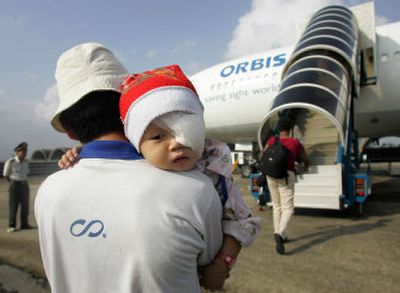Flying hospital brings sight, instruction

DANANG, Vietnam – Lam Vu Nhat Ni perches on her father’s lap, wearing hospital pajamas and squinting as she slowly counts the number of blurry fingers held just 3 feet in front of her.
“Mot, hai, ba, bon,” the 7-year-old whispers in Vietnamese. Born with cataracts that have progressed in the past year, Ni can see the shapes, but it’s a struggle to make out all four digits.
The second-grader, too poor to imagine flying to Thailand or Singapore for advanced medical care, is among a handful of patients selected to have surgery at Danang’s airport aboard ORBIS International’s flying eye hospital – a converted DC-10 complete with operating room and rotating volunteer doctors from around the world.
“Before I only saw planes in the sky, but now that I’m on board a plane I’m really happy,” said Ni, who traveled six hours from her village with her father, who earns just $50 a month farming rice. “I don’t feel like I’m in a hospital.”
The front section of the plane has been converted into a classroom, complete with a medical library and a big screen that broadcasts close-up interactive surgeries from the operating room, located in the middle of the aircraft.
The two-week stop in Danang this month was the flying hospital’s first time in Vietnam, arriving after a four-country tour in Africa. It has traveled to more than 70 developing countries for nearly a quarter century.
The New York-based charity has not only saved or dramatically improved the sight of thousands through surgery on the plane, but estimates it has also trained some 124,000 doctors, nurses and other health workers to perform the procedures themselves.
“If we teach one doctor on board the plane a new operation, it’s more important than operating and restoring sight to 100 patients,” said Oliver Foot, the organization’s president and executive director. “That one doctor will go on himself to operate on thousands of blind people, and he will teach other doctors the skill he’s learned.”
Since the plane began flying in 1982, Foot estimates millions have had their sight restored through the skills passed along by ORBIS doctors. But that is a small dent in the overall level of preventable blindness and eye conditions plaguing the poor.
Before the flying hospital touches down, ORBIS sends a team into the country to ask which procedures doctors want to observe, based on their experience and the equipment available at their hospitals.
In Ni’s case, Dr. Doug Fredrick, a pediatric ophthalmologist from the University of California, San Francisco, removed her cataract alongside Dr. Nguyen Thi Thanh Chi, the only physician in Danang who performs eye surgery on children.
Hunched over Ni inside the mini OR, Fredrick explained every step, offering pointers he has learned over the past 20 years. Vietnamese doctors on board scribbled notes and peppered him with questions.
The results were immediate a day after the surgery when the bandage was removed. She will need glasses but should now be able to read 5-point type.
“Sau!” she shouted instantly when six fingers were held up 10 feet away. “I see everything clear now,” she said, smiling. “I could never see my father so clear.”